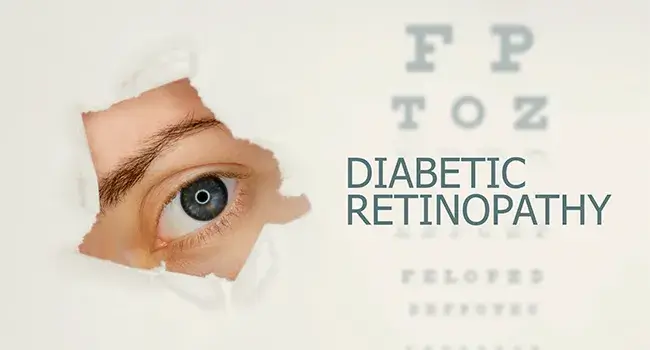We all know that humans can suffer from several different diseases, some of which can be pretty deadly. When we talk about diseases, one of the most common among them is diabetes. Most of you might know someone suffering from diabetes, right? But, do you know that it can lead to severe issues? Yes, you heard it right as Diabetic Retinopathy is one such condition, and we will talk about it today.
Diabetic Retinopathy: What Does It Mean?
As we are talking about diabetes, you should know that it can cause a disease known as diabetic Retinopathy. High blood glucose levels harm the blood vessels in the retina, a portion of the eye, causing this eye condition. Vision issues may result from this. Diabetes is one of the most frequent causes of visual loss and blindness in patients with the disease.
You might be able to avoid contracting it. If you do acquire it, there are methods to sluggish it. Nearly 50% of people with diabetes have some degree of the disease. Early on, those without indications might not even know they have it.
Regular eye checkups are crucial since this illness may worsen and cause permanent vision loss. A clinician can then identify the problem early on, slowing its development. It is good to treat this disease as there are various stages of diabetic Retinopathy, which worsens with each stage.
Stages Of Diabetic Retinopathy: A Look At All Four Of Them
When we talk about diabetic Retinopathy, the first question that comes to our mind is “what are the stages of diabetic Retinopathy?”. Well, let us look at the four stages of diabetic Retinopathy and develop a better understanding of the disease.
1. Mild Nonproliferative Diabetic Retinopathy
Background diabetic Retinopathy is another name for the initial stage or mild NPDR. It indicates that the small blood vessels in your retinas have very slight bulges. Microaneurysms are the name for the lumps. Your retinas may have a little amount of blood leakage due to them. You most likely don’t have vision issues at this preliminary phase; thus, you might not need therapy.
Consult your doctor for advice on how to prevent the deterioration of your situation. You must maintain healthy blood pressure, insulin, and sugar levels. In a year, you should schedule another screening test. You have a high probability of moving to stage 3 in the following three years if your physician diagnoses you with this illness in both eyes.
2. Moderate Nonproliferative Retinopathy
Pre-proliferative Retinopathy is yet another name for moderate NPDR or stage 2. Your retinas’ blood vessels enlarge at this point. Perhaps they don’t transport blood as well as they formerly did. The retina may undergo these changes physically.
These alterations may cause diabetic macular edema (DME). Blood and other fluids accumulate in the macula, a region of your retina, causing this to occur. Straight-ahead vision is essential for activities like reading and driving. Its swelling may interfere with this crucial aspect of your eyesight.
DME will be received by 50 percent of diabetic retinopathy patients. Although it is possible at any point, it is more likely to occur as the illness worsens. The likelihood that the disease will impair your eyesight increases as it advances to this stage. Your physician may advise an eye exam every three to six months.
3. Severe Nonproliferative Diabetic Retinopathy
Additionally known as proliferative Retinopathy, Your blood vessels get considerably more clogged at this point. This implies that the retinas receive significantly less blood. As a result, scar tissue develops. Your retinas receive a message to grow new blood vessels in response to a lack of blood.
Macular ischemia occurs when all of the blood arteries entirely shut down. Sights that are hazy and have black areas that some people refer to as “floaters” may result from this. There is a significant likelihood of losing your eyesight if you get to this point. Medication may halt vision loss. But remember that it’s almost impossible to return if some of your eyesight is already lost.
4. Proliferative Diabetic Retinopathy (PDR)
New blood vessels develop in the eye’s retina and the jelly substance that covers your eyes during this mature phase. Neovascularization is the name for this expansion, and these blood arteries are frail and narrow. They bleed a lot and bruising may result in scar tissue.
The retina may slide away from the rear of your eye as the scar tissue thins down. Do you know what you call this? Well, keep in mind that the term for this is retinal detachment. And it may result in the irreversible loss of side and forward vision.
Why CFS?
Is it that you are also suffering from Diabetic Retinopathy? If yes, don’t waste more time and contact a good eye clinic like Centre For Sight. We have a team of diligent and experienced ophthalmologists who will provide you with the best treatment and experience. We have been there in the industry for a long time and have successfully treated various eye problems of our patients effectively.
Article: Diabetic Retinopathy: Learn All About It!
Author: CFS Editorial Team | July 11 2022 | UPDATED 07:00 IST
*The views expressed here are solely those of the author in his private capacity and do not in any way represent the views of Centre for Sight.





